Key takeaways:
- Post-production is essential for shaping the film’s final narrative, involving sound design, color grading, and visual effects to enhance storytelling.
- Creativity plays a crucial role in post-production, enabling filmmakers to discover new emotional depths through innovative editing techniques and collaborative feedback.
- Creating a conducive work environment, including personalizing the space and managing distractions, significantly impacts the creative process during editing.
- Reflection and adaptation are vital for identifying and implementing necessary changes in the narrative, allowing for growth and innovative breakthroughs in editing.
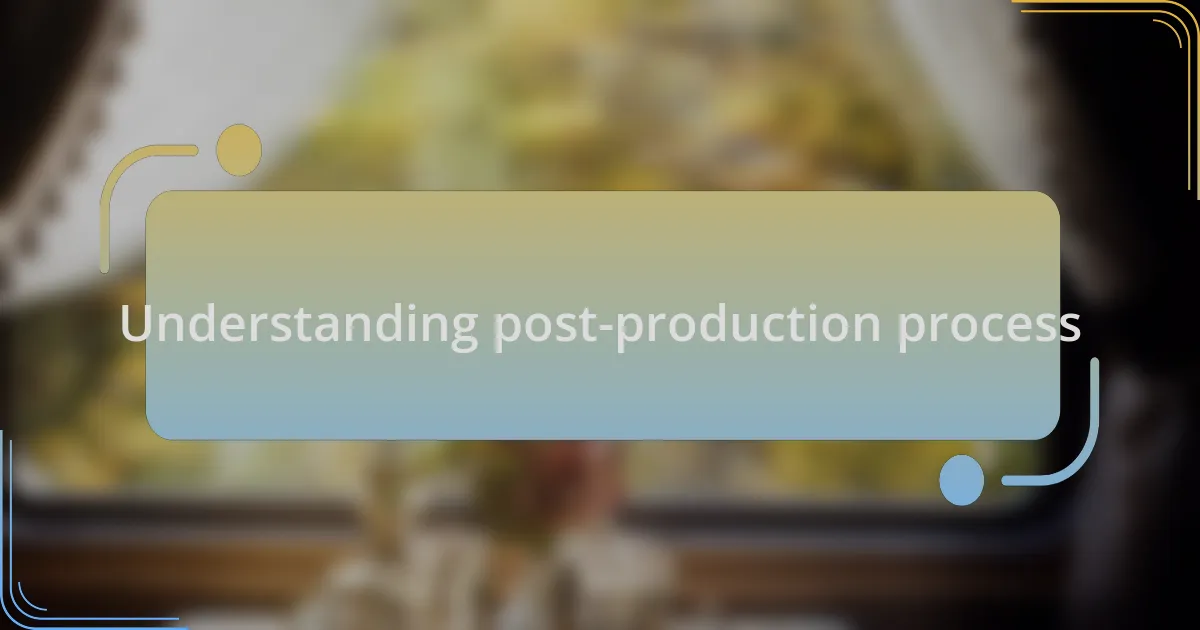
Understanding post-production process
Post-production is the stage where everything comes together to shape the final narrative. It’s more than just editing; it’s where the film finds its voice. I remember the first time I sat in an editing suite, watching raw footage transform into a captivating story—it was almost magical.
During this phase, sound design, color grading, and visual effects can either enhance or detract from the story you’re trying to tell. Have you ever noticed how a well-timed sound effect can evoke an unexpected emotional response? I’ve found that focusing on these nuances can make the difference between a good film and a great one.
Editing can be a solitary process, and that’s when creativity can sometimes feel stifled. When faced with a creative block, I often seek inspiration from films I love or revisit my favorite scenes. It’s amazing how this can reset my perspective and ignite new ideas, reminding me that post-production isn’t just about piecing things together, but about breathing life into the vision.
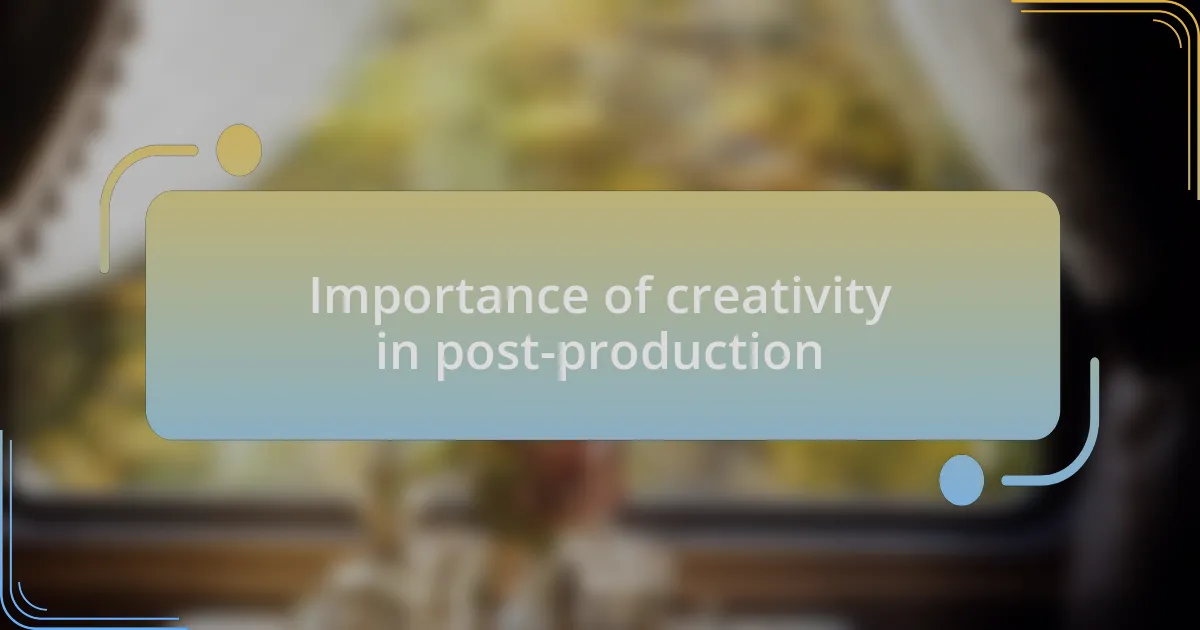
Importance of creativity in post-production
In post-production, creativity is paramount as it allows filmmakers to craft a distinct identity for their narrative. I vividly recall a project where my initial edit fell flat, lacking the emotional punch I was aiming for. By employing creative editing techniques, such as rhythm manipulation and color shifts, I unearthed a richer emotional landscape that resonated deeply with audiences.
Without creative approaches, you might overlook crucial storytelling elements hidden within your footage. There was a time when I underestimated the power of a simple jump cut, thinking it was too abrupt. But after experimenting, I discovered it can lend a fresh urgency to a scene, engaging viewers in ways I hadn’t anticipated. Have you ever considered how a small change in edit style can completely shift the narrative’s impact? It’s these creative choices that breathe life into mere frames.
Additionally, the collaborative aspect of post-production thrives on creativity. Working with sound designers and colorists, I found that bouncing ideas off one another ignited sparks of inspiration. During one session, a sound effect idea I initially dismissed became the cornerstone of a climactic scene. Being open to collaboration not only fuels my creativity but also transforms the overall film, highlighting the profound importance of creativity in this stage of production.
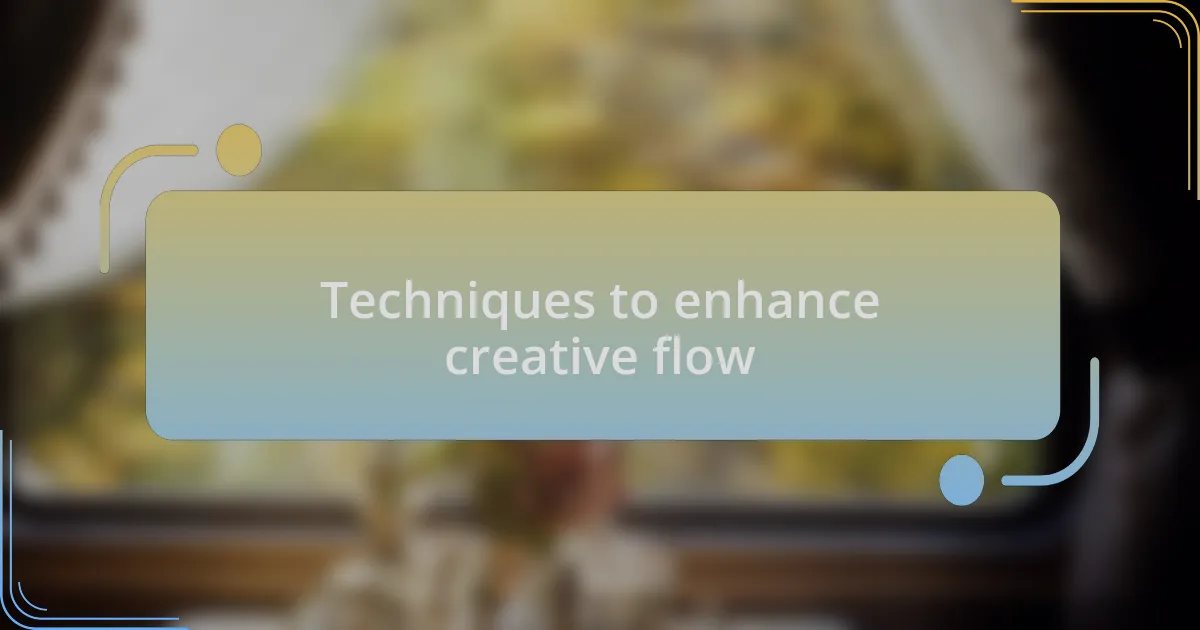
Techniques to enhance creative flow
One effective technique to enhance creative flow is to change your environment. I remember a time when I felt stifled working in my usual editing suite. By moving to a coffee shop, surrounded by the hum of conversation, I found new energy and perspective, which led to innovative ideas that reinvigorated my project. Have you ever noticed how a simple shift in scenery can spark unexpected inspiration?
Another method is to set aside dedicated time for free experimentation without the pressure of deadlines. I often carve out a “play day” where I explore various editing styles or effects that I wouldn’t typically consider. This playful approach takes the weight off my shoulders, allowing me to stumble upon creative techniques that surprise and delight me. Could giving yourself permission to explore freely unlock untapped creative potential in your work?
Lastly, incorporating different art forms can stimulate fresh ideas. For instance, during a particularly challenging edit, I started watching a series of dance performances. The fluidity and rhythm of the movements inspired me to think outside the box about pacing in my edits. Have you ever found inspiration in an unexpected place outside your usual craft? Embracing diverse influences not only enriches the editing process but also fosters a deeper emotional connection to the story I’m crafting.
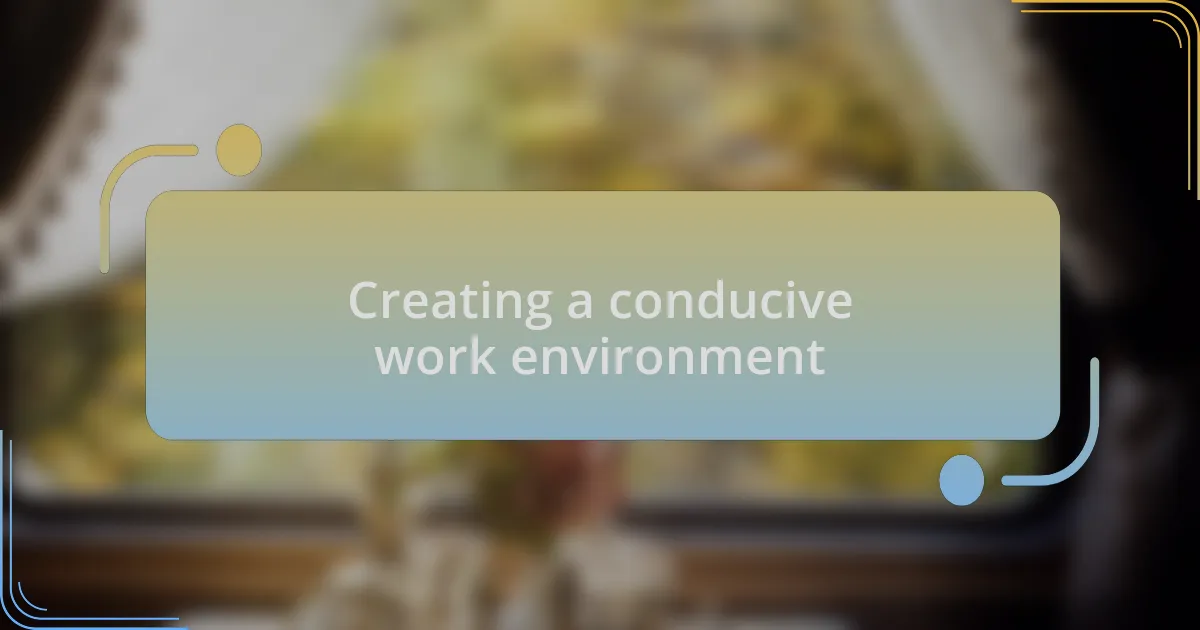
Creating a conducive work environment
Creating a conducive work environment is essential for nurturing creativity during post-production. I’ve learned that personalizing my workspace can have a profound effect on my mindset. When I adorn my editing room with photos from past projects and artwork that inspires me, I create a space that not only feels comfortable but also sparks my creativity. Have you ever considered how the visual elements around you can shape your mental state?
Additionally, controlling the level of noise and distractions plays a crucial role in maintaining focus. I once experimented with ambient soundtracks while editing; it was remarkable how background music tailored to fit the mood of my project helped me dive deeper into the creative process. How do you manage the distractions in your environment to stay on track?
Lastly, maintaining a consistent work schedule can transform your environment into a sanctuary of productivity. As someone who thrives on routine, I find that setting specific hours for editing helps signal to my brain that it’s time to create. Have you noticed how establishing a rhythm can keep distractions at bay and enhance your focus?
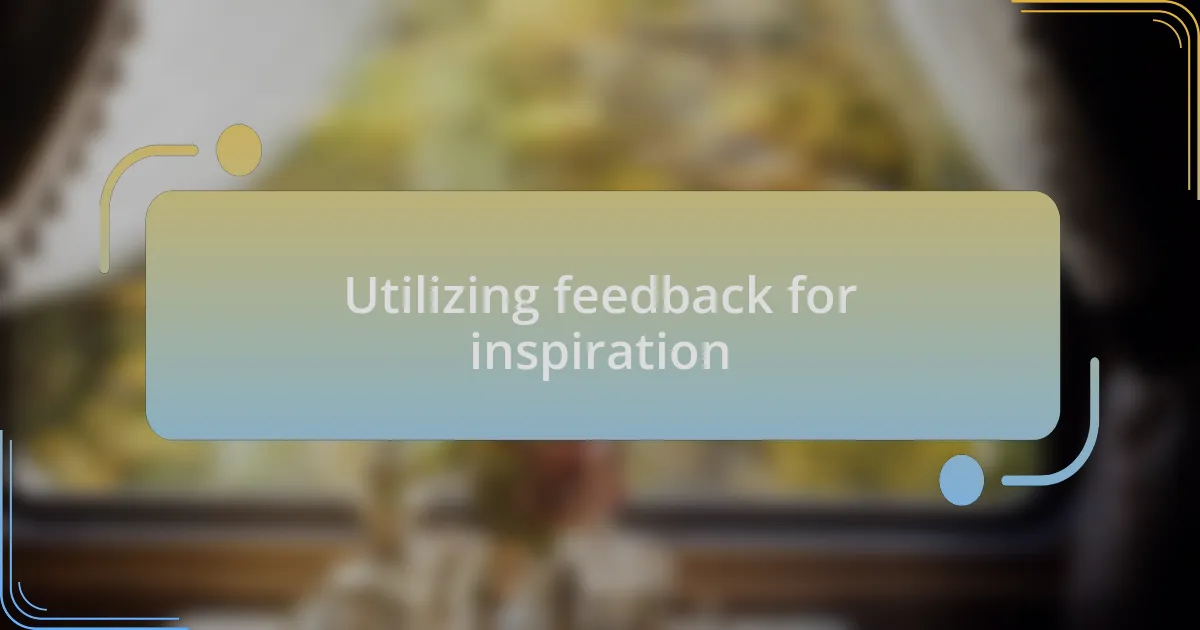
Utilizing feedback for inspiration
Utilizing feedback effectively can be a catalyst for creative inspiration in post-production. I recall a time when I was deep in the editing of a documentary, feeling stuck and unsure about the flow of the narrative. After sharing a rough cut with a close colleague, their fresh perspective opened my eyes to moments I had overlooked, which ultimately reignited my passion for the story. Have you ever felt that a second opinion could illuminate a path you hadn’t considered?
Incorporating feedback isn’t just about making changes; it’s about embracing new ideas that might elevate your project. When I reviewed comments from my team, it struck me how each piece of feedback, whether positive or critical, offered a unique lens through which to view my work. I often find myself jotting down insights that resonate with me, allowing them to percolate in my mind as I continue editing. How do you integrate suggestions into your creative process without losing your vision?
I also learned that fostering a culture of open communication invites more honest feedback. Once, during a group review session, I accidentally discovered a hidden gem in a colleague’s observation that transformed a specific scene for the better. Those moments remind me that collaboration can breathe new life into projects, pushing creativity beyond what I thought was possible. Isn’t it incredible how a few words can spark a complete shift in perspective?
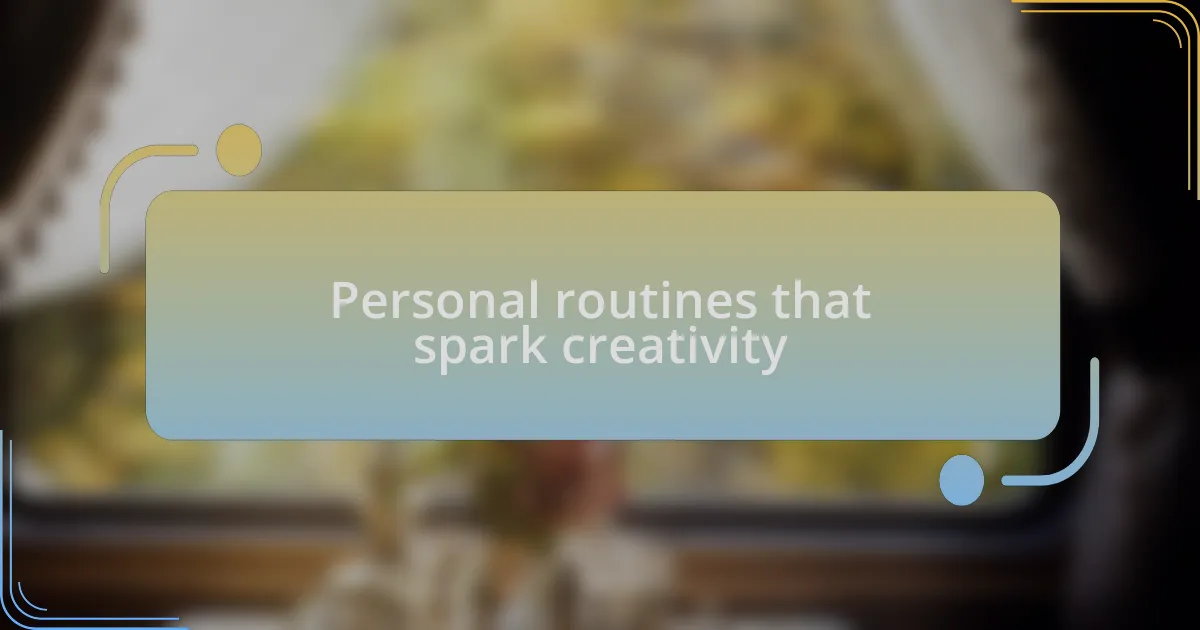
Personal routines that spark creativity
Establishing personal routines that nourish creativity can be a game-changer during the often tedious post-production phase. For me, starting each day with a brisk walk allows for a mental reset, clearing my mind of clutter and inviting fresh ideas to flow. Have you ever noticed how a change in environment shifts your perspective? I’ve often found that nature acts as a silent muse, inspiring thoughts that weave seamlessly into my editing work.
Incorporating rituals, like setting aside dedicated time for brainstorming or journaling, often helps in unlocking new pathways of creativity. I remember a particularly challenging project where I dedicated Sunday mornings to sketching out concepts on paper, free from the constraints of screens and edits. This practice not only invigorated my thought process but also led to unexpected visual solutions that I didn’t initially consider. When was the last time you allowed yourself the freedom to explore ideas without restriction?
Taking intentional breaks is another routine that I find crucial. Whenever I hit a creative wall, I step away and immerse myself in a contrasting experience—like cooking a new recipe or diving into a book. Those moments of disengagement often result in a burst of inspiration when I return to my work. It’s fascinating how stepping back can give us the clarity we need, isn’t it?
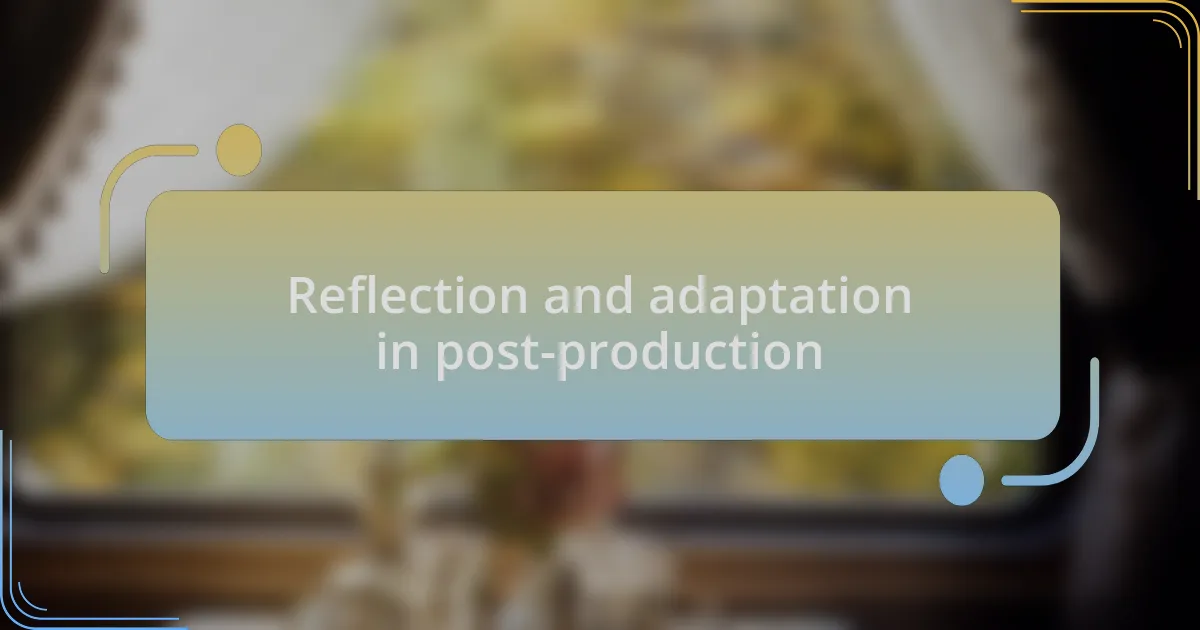
Reflection and adaptation in post-production
Reflection plays a pivotal role in the post-production process. After hours of editing, I often find it beneficial to take a moment and ask myself, “What story am I truly trying to tell?” This simple question can ignite a fresh perspective that drives the revisions necessary to enhance the film’s narrative. Finding the courage to step back and assess my work objectively often reveals opportunities I hadn’t spotted during the heat of the editing frenzy.
Adaptation is equally crucial in this phase. I recall a project where I initially struggled with pacing in a montage sequence. While reviewing the footage, I realized I needed to shift my approach to the rhythm of the cuts. By experimenting with different timing and transitions, I not only addressed the pacing issue but also unlocked an emotional resonance in the scene I hadn’t anticipated. Adapting to what the material presents, rather than forcing my preconceived notions onto it, can lead to surprising breakthroughs.
Sometimes, I think, “What if I allow myself to embrace mistakes?” Accepting that not every decision will yield the desired outcome is liberating. I once deleted an entire section I had labored over, realizing it didn’t align with the film’s essence. That moment of letting go was tough, yet it opened up space for a new narrative flow to emerge. It’s a poignant reminder that reflection and adaptation are not only practices but also gateways to creativity in post-production.